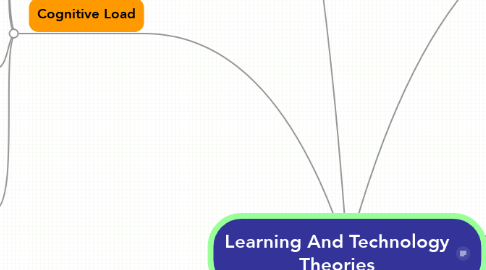
1. Cognitive Load
1.1. The mind is similar to a computer
1.2. Memory
1.2.1. Sensory
1.2.2. Short term/ Working
1.2.3. Long Term
1.2.3.1. Virtually unlimited; assists short term
1.2.3.2. Includes schemas written by working memory
1.2.3.2.1. Can create Automation with repeated effort and lots of practice
1.2.4. Can handle 7 disconnected items at once!
1.3. Overload can be...
1.3.1. Extraneous: the outside world is too overwhelming!
1.3.2. Intrinsic: imposed on by the learning task
1.3.3. Germane: devoted to processing information, construction and automation of schema
1.4. When teaching, be aware of the loads your students are facing
1.4.1. Is that clip art or text really necessary?
1.4.2. Chunk information
1.4.2.1. mneumonic devices, graphic organizers etc
1.4.3. Provide opportunity for repetition
1.4.4. Elegant Design
2. Constructivism
2.1. Problem solving, group collaboration, and student accountability for their own learning is emphasized
2.1.1. Give a real world context for problem solving
2.2. Essentially: Build Connections!
2.3. Learning through participation
2.4. More Collaborative or Student Directed (active learning and engagement)
2.5. Students construct their own knowledge based on a foundation of previous learning
2.5.1. Zone of Proximal Development (Vygotsky)
2.5.2. Essentially: Build Connections
3. Media Ecology
3.1. We do not influence technology; technology influences society
3.1.1. Concerns about the interaction between technology and human thought/behaviour and action
3.1.2. Media creates roles implicitly and informally
3.2. Communication Matters!
3.3. "the study of complex communication systems (media) as environments"
3.4. Objective is to shed light on the interactions and impacts
4. Teachnology
4.1. Your Philosophy of Teaching combined with beliefs on how technology should be used by educators
4.1.1. Incorporate traditional skills and apply them to a digital age
4.1.1.1. Grammar
4.1.1.1.1. Making yourself understood
4.1.1.2. Writing
4.1.1.2.1. Blogging
4.1.1.2.2. Chatting
4.1.1.2.3. Discussion posts
4.1.1.3. Reading
4.1.1.3.1. Online resources
4.1.1.3.2. Blogs
4.1.1.4. Professionalism
4.1.2. As part of a Professional Learning Network
4.1.3. As tools to assist in the classroom
4.2. A written statement that can be re-assessed and updated regularly to reflect changes
5. Connectivism
5.1. Knowledge exists in connections
5.1.1. Provided primarily by technology?
5.1.2. Use any tool that enables these connections
5.2. Is learning formal or informal here?
5.3. Integration of chaos, network, complexity and self organization theories
5.3.1. Chaos: an opportunity for sense and meaning-making
5.3.1.1. Recognizes connections between everything
5.3.1.1.1. Butterfly Effect
5.4. Learning can reside outside humans (in appliances)
5.5. Capacity (potential) to learn is more important that what is currently known
5.6. Significant impact of the design of learning environments!
6. SCOT
6.1. Society influences the direction and scope of technology
6.1.1. Need to understand how technology is embedded in its social context
6.1.2. Acceptance and rejection of technology is based on what we value
6.1.2.1. We: stakeholders, the audience, society as a whole?
6.2. Formalizes the analysis of technology as success or failure
6.3. Concepts:
6.3.1. interpretive flexibility: different meanings to different groups
6.3.2. Relevant social groups
6.3.3. Design flexibility: multitudes of ways to design technology
6.3.3.1. Closure: when a design is "good"
6.3.4. Problems and conflicts: social concerns give way to design adjustments
7. TPACK
7.1. Knowledge
7.1.1. Content
7.1.1.1. The knowledge to be shared - curriculum
7.1.2. Pedagogy
7.1.2.1. Practices and processes of teaching
7.1.3. Technology
7.1.3.1. Ways to think about use technology
7.1.4. Illustrated using three overlapping circles in a Venn diagram
7.1.4.1. Overlaps between the 3 kinds of knowledge are a new category (i.e. PCK, TCK, PTK, and TPACK)
